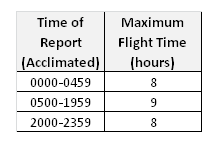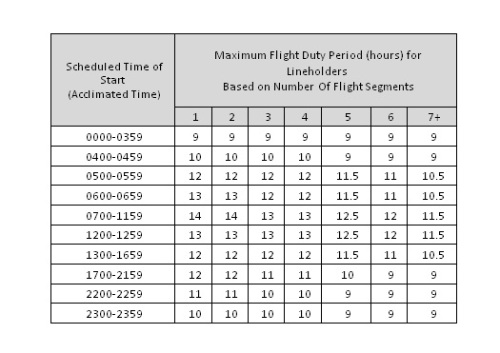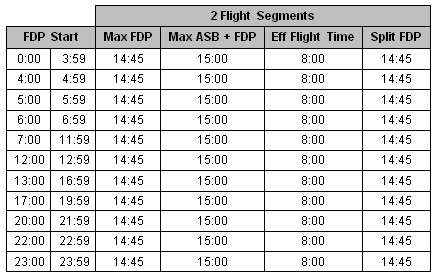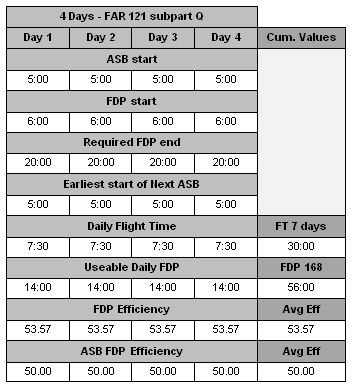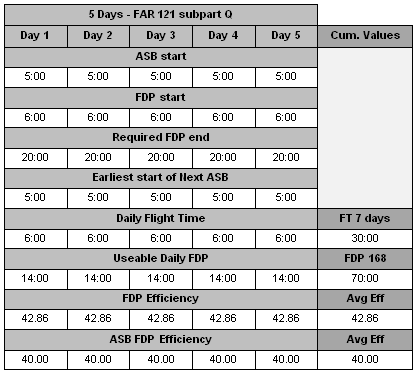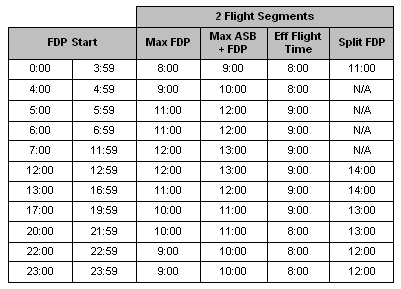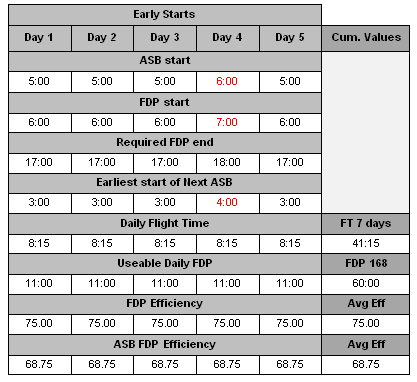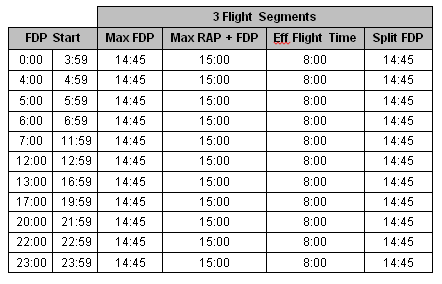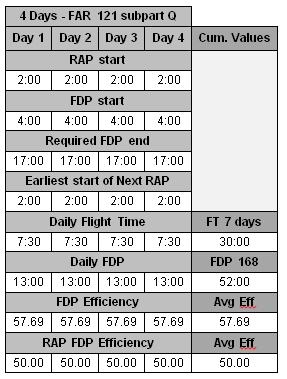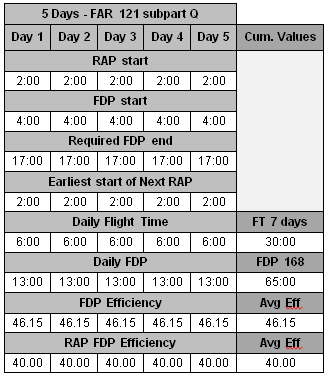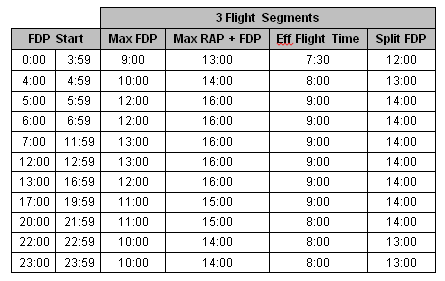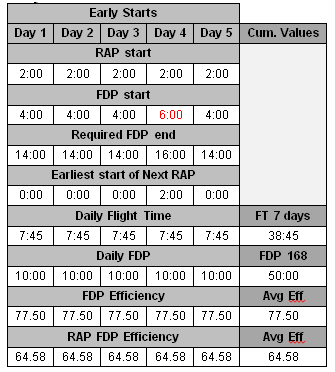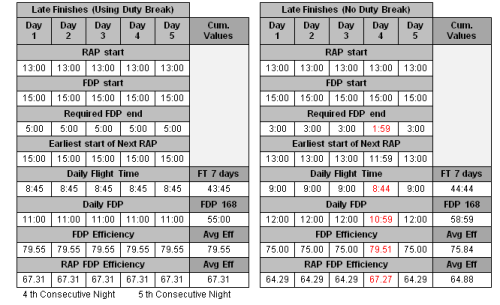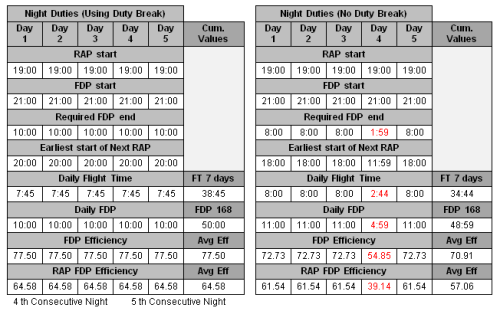By
Garret Healy, Software Engineer, Jeppesen Inc.
Joshua Foltz, First Officer, Allegiant Air
Abstract:
The author’s developed the following tables as a crew planning tool. These tables demonstrate how strict FAR Part 117 work rules are in relation to allowed duty time when compared to FAR part 121 subpart Q.
The particular problems surrounding WOCL rules associated with reserve assignments pose vastly different situations under FAR 117, dependent upon the type of reserve associated with the FDP assigned, and the time of day with respect to when the reserve begins and the time of day that the FDP begins, while under FAR 121 subpart Q, no distinction in accordance to the diurnal variance had ever been stipulated.
Our models will differ from our previous articles, in that we will concentrate less upon duty period construction, and more upon flight crewmember Rostering / Lines construction. The constraints now posed under FAR 117 are dependent upon consecutive days associated with the WOCL, as well as the cumulative FDP constraints under FAR 117 and the cumulative flight time constraints under FAR 121 subpart Q.
Airlines must schedule efficient Flight Duty Periods and carefully plan when Flight Duty Periods begin as well as how many segments are involved.
In order to schedule efficient pairings, the Airlines should consider looking at productive hours (flight time) versus non-productive hours (FDP time)/Combined ASB FDP time.
Definitions:
Airport/standby reserve (ASB):
Is defined in FAR part 117.
Means a defined duty period during which a flightcrew member is required by a certificate holder to be at an airport for a possible assignment.
Duty:
Is defined in FAR part 117.
Means any task that a flightcrew member performs as required by the certificate holder, including but not limited to flight duty period, flight duty, pre- and post-flight duties, administrative work, training, deadhead transportation, aircraft positioning on the ground, aircraft loading, and aircraft servicing.
Duty Break:
Must meet the following criteria:
- Is scheduled before the start of the FDP.
- Is at least 3 hours.
- Is not provided until after the first segment in the FDP has been completed.
- Is provided between 22:00 and 05:00 local time.
- Is measured from the time that the flightcrew member reaches the suitable accommodation.
- Duty breaks cannot be reducible from scheduled. Even during delays, the scheduled duty break cannot be reduced
Flight Duty Period (FDP):
Is defined in FAR part 117.
Means a period that begins when a flightcrew member is required to report for duty with the intention of conducting a flight, a series of flights, or positioning or ferrying flights, and ends when the aircraft is parked after the last flight and there is no intention for further aircraft movement by the same flightcrew member. A flight duty period includes the duties performed by the flightcrew member on behalf of the certificate holder that occur before a flight segment or between flight segments without a required intervening rest period. Examples of tasks that are part of the flight duty period include deadhead transportation, training conducted in an aircraft or flight simulator, and airport/standby reserve, if the above tasks occur before a flight segment or between flight segments without an intervening required rest period.
Flightcrew member (FCM):
Is a pilot, flight engineer, or flight navigator assigned to duty in an aircraft during flight time.
Is defined in FAR part 1.
Flight Time:
Is defined in FAR part 1.
Commences when an aircraft moves under its own power for the purpose of flight and ends when the aircraft comes to rest after landing.
Long-call reserve (LCR):
Is defined in FAR part 117.
Means that, prior to beginning the rest period required by 117.25, the flightcrew member is notified by the certificate holder to report for a flight duty period following the completion of the rest period.
Pre-Flight Duties:
Includes reporting for an assignment, acknowledging flights to be performed while on duty that will be operated in accordance to FAA regulations, including understanding of the expected conditions that will affect the flight(s) to be performed. Inspections of the aircraft for flight readiness, etc.
Reserve availability period (RAP):
Is defined in FAR part 117.
Means a duty period during which a certificate holder requires a flightcrew member on short call reserve to be available to receive an assignment for a flight duty period.
Reserve flightcrew member:
Is defined in FAR part 117.
Means a flightcrew member who a certificate holder requires to be available to receive an assignment for duty.
Short-call reserve (SCR):
Is defined in FAR part 117.
means a period of time in which a flightcrew member is assigned to a reserve availability period.
Split duty:
Is defined in FAR part 117.
Means a flight duty period that has a scheduled break in duty that is less than a required rest period.
Suitable accommodation:
Is defined in FAR part 117.
Means a temperature-controlled facility with sound mitigation and the ability to control light that provides a flightcrew member with the ability to sleep either in a bed, bunk or in a chair that allows for flat or near flat sleeping position. Suitable accommodation only applies to ground facilities and does not apply to aircraft on-board rest facilities.
Window of circadian low (WOCL):
Is defined in FAR part 117.
Means a period of maximum sleepiness that occurs between 0200 and 0559 during a physiological night.
Note: The WOCL is based off of flight crew members last acclimated time.
Assumptions:
Brief time:
The amount of pre-flight duty before the flight departs the gate. Typically ranges between 0:45 to 1:00; generally contained within a CBA; for the purposes of this paper we will use 1:00.
Debrief time:
The amount of post-flight duty after the flight arrives at the gate. Typically ranges between 0:15 to 0:30; generally contained within a CBA; for the purposes of this paper we will use 0:15.
Minimum Connect Time:
The minimum time from when an aircraft arrives at the gate, to the time when the aircraft moves away from the gate to allow for sufficient time to unload/load passengers and baggage, and make any required service needs for the aircraft before departure as well as performance of pre-flight checklists, for the purposes of this paper we will use 0:30.
Permissible Extensions to FDP:
Under FAR 117.19, it is permissible to operate beyond the scheduled limitations in FAR 117.13 by 0:30, extensions up 2:00 may be conducted before departure under certain conditions, for the purposes of this paper we will use 0:00.
Rest Requirements:
For the purposes of this paper, a FCM will always be in compliance with the following requirements:
- Under 117.25, FCM’s are required to have been scheduled for and have been given a rest period of no less than 30 hours in the 168 consecutive hours preceding the start of a FDP.
- Under 121 subpart Q, FCM’s are required to have been scheduled for and have been given a rest period of no less than 24 hours in the 7 calendar days preceding the scheduled completion of any flight subject to this subpart.
Minimum Duty Break:
FAR 117.15 mandates that the minimum time spent in a suitable accommodation is 3:00.
Travel Time:
FAR 117.15, mandates that the time to travel to/from the location used as a suitable accommodation is not part of the required duty beak; generally, the location is relatively close-by. For the purposes of this paper we will use 0:15 each way for travel time, this will equate to 0:30.
Flight Segments:
FAR 117.13 contains different FDP limitations based upon the number of flight segments, for the purpose of this paper all FDP will have 2 flight segments.
Acclimated:
FAR 117.13, mandates that a 0:30 penalty be applied to the FDP limitations in Table B when a FCM reports for an FDP in an un-acclimated state. For purposes of this paper a FCM will be assumed to be in an acclimated state, no penalty shall be applied.
Airport/Standby:
A FCM may be re-assigned to an assignment, which contains flight time at any time during an ASB after the FCM reports. For the purposes of this paper it will be assumed that a FCM will serve 1:00 of FDP exclusively on ASB, before being assigned any flight time.
Nature of reserve assignments:
Long Call Reserve (LCR) – a FCM is notified that an FDP or SCR assignment has been made and the span of time from point of notification to the start of the assignment will allow for a rest period and any required travel time.
Airport/Standby Reserve (ASB) – a FCM is at the airport and is subject to immediate assignment to an assignment, which includes Flight Time.
Short Call Reserve (SCR) –a FCM is expected to report for the FDP without an intervening rest period. Since the FCM may need to travel to the location where the FDP will start, most airlines will have a minimum amount of time to allow for the ‘call out’.
The amount of time from the start of the short-call reserve until the report for the FDP is known as RAP, Reserve Availability Period, it includes the ‘call out time’, and may not exceed 14 hours.
Specific regulatory provisions applied:
Daily Flight Time Limitations (FTL):
1 Part 117 has Daily FTL’s governed under 117.11.
- Based upon FDP start time, the limitation is either 8:00 or 9:00 as defined in Table A.
- Evaluated on a leg by leg basis, FCM may not continue a flight if before takeoff it is known that the FTL will be violated.
Table A
2 Part 121 has Daily FTL’s governed under 121.471(a)(4).
- The scheduled limitation is 8:00.
- A FCM may continue the assigned FDP as long as the flight itinerary is the same as what the FCM began with no further constraints (legal to start, legal to finish), else a reevaluation at the point of rescheduling must take place.
Daily FDP Limitations:
1 Part 117 has Daily FTL’s governed under 117.13.
- Based upon FDP start time, the scheduled limitation is defined in Table B.
- Extensions to the assigned FDP are permitted in accordance with 117.19.
Table B
2 Part 121 does not actually have FDP limitations, instead a complicated system based upon 121.471(b) and (c):
- A scheduled flight time in the 24 hours preceding the scheduled completion of a flight segment.
- A required rest period in the 24 hours preceding the actual expected completion of a flight segment. The may be reduced due to operational contingencies before takeoff.
A compensatory rest period will be required following the release of a duty period that is preceded by a reduced rest period, this will effectively limit the duty period to a maximum of 16 or 15 hours dependent upon the scheduled flight time in the 24 hour period, and the compensatory rest period must commence within 24 hours of the start of the reduced rest period.
Consecutive nighttime operations.
1 Part 117 has Consecutive nighttime operations governed under 117.27.
- Up to 5 consecutive calendar days where a FDP infringes upon any portion of the WOCL, will be permitted under the following conditions:
i. Each FDP will have a rest opportunity of at least 2 hours,
ii. The rest opportunity measured from the time that the flightcrew member reaches the suitable accommodation,
iii. The rest oppurtunity must comply with the conditions specified in 117.15(a), (c), (d), and (e).
- Otherwise, the limitation is 3 Consecutive nighttime operations.
2 Part 121 subpart Q has no limitations.
Authors note: An early morning FDP assignment can also be considered a night duty when the FDP starts at any time between 02:00 and 05:59 (inclusive).
Cumulative Limitations.
1 Part 117.23 has the following Cumulative Limitations:
- Cumulative flight time limitations of:
i. 100 hours in any 672 consecutive hours.
ii. 1000 hours in any 365 calendar days
- Cumulative FDP limitations of:
i. 60 hours in any 168 consecutive hours.
ii. 190 hours in any 672 consecutive hours
2 Part 121 subpart Q has the following Cumulative Limitations:
- Cumulative flight time limitations of:
i. 30 hours in any 7 calendar days.
ii. 100 hours in any calendar month.
iii. 1000 hours in any calendar year
Reserve status.
1 Part 117 has specific limitations for FCM assigned to reserve assignments governed under 117.21.
- All reserve assignments are considered to be duty for the purposes of determination of all rest requirements under 117.25.
- Airport/Standby (ASB) Reserve is considered FDP and is subject to the FDP Limitations (117.13) in Table B and the Flight Time Limitations (117.11) in Table A using the start time of the assignment. ASB is subject to the Consecutive nighttime operations under 117.27 as well as the rest requirements under 117.25.
- Short-Call Reserve (SCR) is not considered FDP, but is considered to be on RAP. RAP has specific limitations for while on RAP and combined RAP and FDP limitations for FDP’s assigned during the RAP. RAP’s are subject to the rest requirements under 117.25.
- Long-Call Reserve (LCR) is not considered FDP and is not subject to the rest requirements under 117.25, but before being assigned to and FDP or SCR assignment the rest requirements must be satisfied, and should the FDP start before the WOCL and continue into the WOCL at least 12 hours notification must have been given.
2 While Part 121 subpart Q no specific limitations for FCM assigned to reserve assignments, A FCM is considered to be on duty, and when assigned to a duty that contains flight time, will still be subject to the pertinent flight time limitations and rest requirements under section 121.471(b) and (c).
Objective comparisons of combined ASB FDP
FDP:FAR 121 subpart Q
FDP Efficiency = Daily Flight Time / Useable Daily FDP
ASB FDP Efficiency = Daily Flight Time /(Useable Daily FDP + (FDP Start – ASB Start))
FAR 117
FDP Efficiency = Daily Flight Time / Useable Daily FDP
ASB FDP Efficiency = Daily Flight Time /(Useable Daily FDP + (FDP Start – ASB Start))
Early Starts
Late Finishes
Night Duties
Conclusions:
FAR 121 subpart Q, is less efficient when compared to FAR 117, this is due to the weekly flight time limitation of 30 hours in 7 calendar days, this limits the daily flight time to an average of 6:00 across 5 calendar days, and 7:30 hours across 4 calendar days.
FAR 121 subpart Q, is not constrained by diurnal variations, thereby, the average FDP efficiency and the average Combined ASB FDP efficiency remains constant across all time frames at 42.86/40.00 for 5 calendar days, and 53.57/50.00 for 4 calendar days.
FAR 117, showed Early Start Duties had average efficiencies of 75.00/68.75 for FDP/Combined ASB FDP, respectfully. Day 4, was constrained to have an ASB start no earlier than 6:00 due to the inability to apply a Duty Break. These efficiencies were the highest observed.
FAR 117, showed the worst efficiencies for Night Duties. When the Night Duty apply a Duty Break of 3:00 the efficiencies 47.50/43.18 for FDP/Combined ASB FDP. The efficiencies improve when the duty break is not applied, 66.96/60.19 for FDP/Combined ASB FDP, respectfully. Day 4, was severely constrained to a very short FDP/Combined ASB FDP with a very low flight time.
FAR 117, showed the same type of trend with Late Finishes. When the Late Finishes apply a Duty Break of 3:00 the efficiencies 52.27/47.92 for FDP/Combined ASB FDP. The efficiencies improve when the duty break is not applied, 73.88/67.49 for FDP/Combined ASB FDP. Day 4, was severely constrained to a very short FDP/Combined ASB FDP with a low flight time.
The increase in efficiencies when the duty break is not applied, was primarily due to the ability to use some of the time occupied by the duty break with flight time.
Under FAR 117 and FAR 121 subpart Q, if the amount of time a FCM is required to sit on ASB increases, the efficiencies diminish; this is expected, as ASB time is viewed as unproductive time.
Under FAR 117 and FAR 121 subpart Q, if the numbers of flight segments increases, the efficiencies diminish, this is expected, as the minimum connect time will diminish the amount of available time for flight time.
Recommendations:
Allowing a FCM to serve on ASB beyond 3:00 hours before beginning an assignment that includes Flight time seems impractical when no duty break will be applied, if a duty break is applied 4:00 seems to be the limit.
Scheduling a FCM for more than 3 days for the Late Finishes and Night Duties with no duty break seems to be impractical especially when a FCM to serve on ASB for more than 2:00 before beginning an assignment that includes Flight time.
FAR 121 subparts Q versus Part 117 – Impact of WOCL on Airport – Standby Reserves

